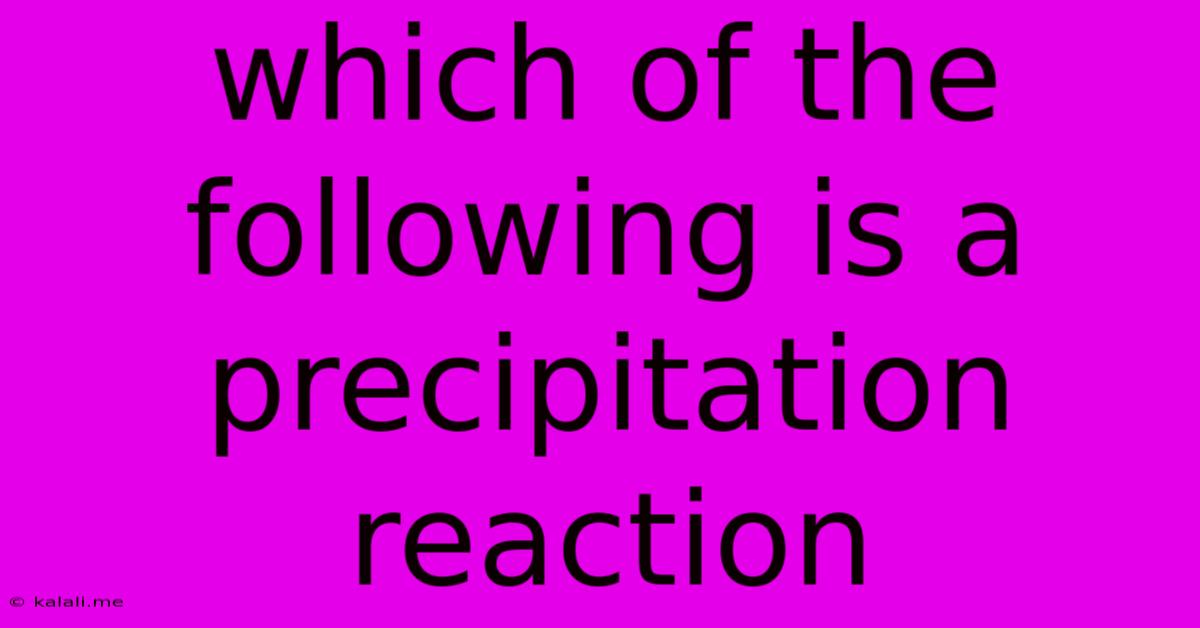Which Of The Following Is A Precipitation Reaction
Kalali
Jun 15, 2025 · 3 min read

Table of Contents
Which of the Following is a Precipitation Reaction? Understanding Precipitation Reactions in Chemistry
This article will delve into precipitation reactions, explaining what they are, how to identify them, and providing examples to help you understand this fundamental chemistry concept. A precipitation reaction is a type of chemical reaction where two soluble salts in aqueous solution react to form an insoluble salt called a precipitate. This precipitate, often a solid, separates from the solution, making it visually apparent. Understanding how to identify a precipitation reaction is crucial for many areas of chemistry, including qualitative analysis and synthesis.
What are the Characteristics of a Precipitation Reaction?
Precipitation reactions are characterized by several key features:
- Two aqueous solutions: The reactants are always dissolved in water. This allows the ions to freely move and interact.
- Formation of a solid precipitate: The key indicator is the formation of a solid that separates from the solution. This solid is the precipitate, and its formation is usually observable as cloudiness or the settling of a solid at the bottom of the container.
- Ionic compounds: The reactants and products are typically ionic compounds, meaning they are composed of ions with opposite charges.
- Solubility rules: Predicting whether a precipitation reaction will occur relies heavily on understanding solubility rules. These rules dictate which ionic compounds are soluble (dissolve in water) and which are insoluble (do not dissolve significantly in water).
Identifying a Precipitation Reaction: A Step-by-Step Guide
To determine if a given reaction is a precipitation reaction, follow these steps:
- Write out the balanced chemical equation: This will clearly show the reactants and products involved.
- Identify the ions present in the solution: Dissociate the soluble ionic compounds into their constituent ions.
- Determine the possible products: Consider all possible combinations of cations and anions from the reactants.
- Consult solubility rules: Use solubility rules to predict the solubility of each potential product. If a product is insoluble (or sparingly soluble), a precipitate will form.
- Write the net ionic equation: This equation only includes the ions directly involved in the precipitate formation. Spectator ions (ions that don't participate in the reaction) are omitted.
Examples of Precipitation Reactions
Let's look at some examples to solidify our understanding. Consider the following reactions:
-
Reaction 1: Silver nitrate (AgNO₃) and sodium chloride (NaCl) react to form silver chloride (AgCl) and sodium nitrate (NaNO₃). AgCl is insoluble, forming a white precipitate. This is a classic example of a precipitation reaction.
-
Reaction 2: Lead(II) nitrate (Pb(NO₃)₂) and potassium iodide (KI) react to form lead(II) iodide (PbI₂) and potassium nitrate (KNO₃). PbI₂ is a bright yellow precipitate. This reaction is also a precipitation reaction.
-
Reaction 3 (Non-Precipitation): Sodium chloride (NaCl) and potassium nitrate (KNO₃) both dissolve in water. When mixed, no precipitate forms; all ions remain dissolved in solution. This is not a precipitation reaction.
Practical Applications of Precipitation Reactions
Precipitation reactions have numerous applications in various fields including:
- Water purification: Removing unwanted ions and contaminants.
- Chemical synthesis: Preparing pure compounds.
- Qualitative analysis: Identifying the presence of specific ions in a solution.
- Environmental remediation: Removing heavy metals from polluted water.
By understanding the key characteristics and applying the steps outlined above, you can accurately identify precipitation reactions and appreciate their significance in chemistry. Remember to always consult solubility rules to predict the formation of a precipitate. This knowledge is crucial for various aspects of chemistry, from laboratory experiments to industrial applications.
Latest Posts
Latest Posts
-
How Are Observations And Inferences Different
Jun 15, 2025
-
Describe The Advantages And Disadvantages Of Different Types Of Maps
Jun 15, 2025
-
Derived Character States Shared By Clade Members Are Called
Jun 15, 2025
-
Which Of The Following Is The Largest
Jun 15, 2025
-
A Real Gas Behaves Most Like An Ideal Gas At
Jun 15, 2025
Related Post
Thank you for visiting our website which covers about Which Of The Following Is A Precipitation Reaction . We hope the information provided has been useful to you. Feel free to contact us if you have any questions or need further assistance. See you next time and don't miss to bookmark.